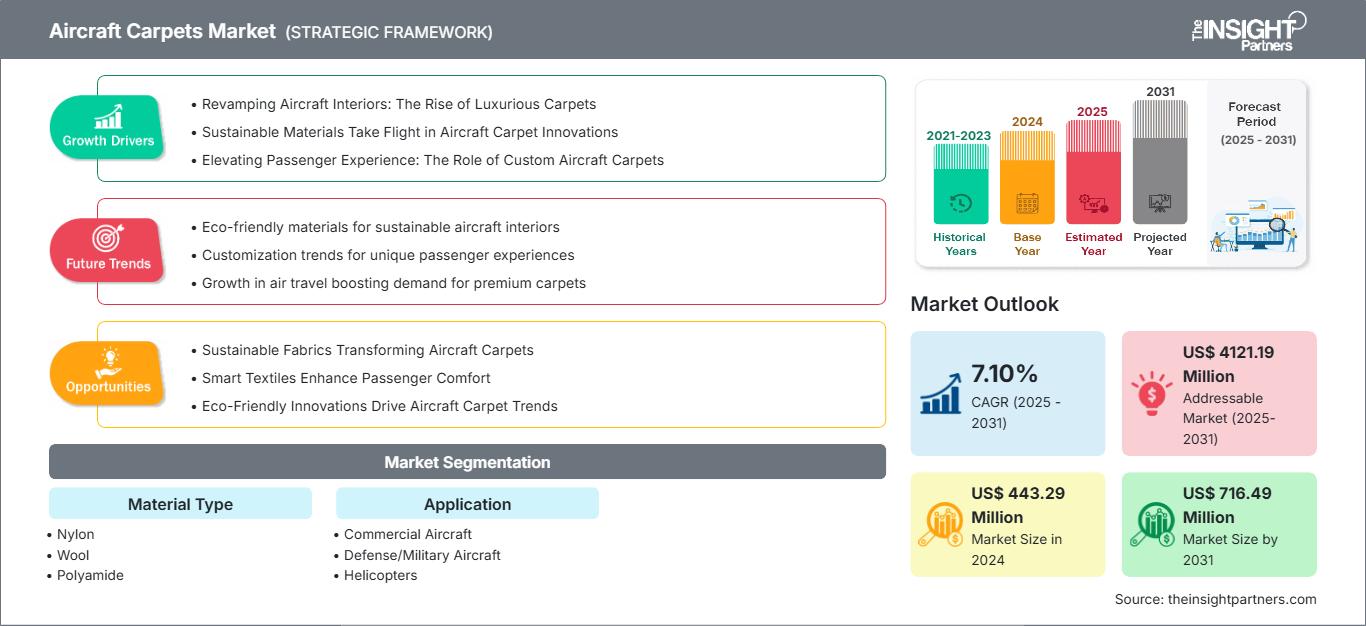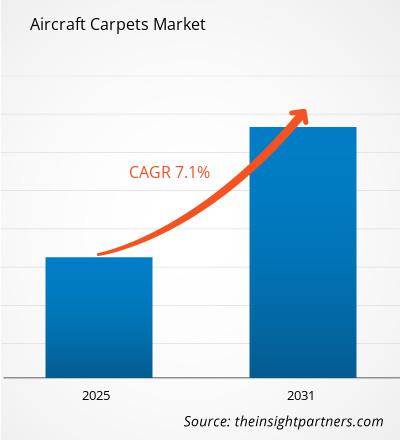Il mercato dei tappeti per aeromobili, valutato a 474,72 milioni di dollari nel 2025, dovrebbe raggiungere gli 879,37 milioni di dollari entro il 2034, con un CAGR del 7,10% nel periodo 2026-2034. Le condizioni di mercato continuano a evolversi, aprendo nuove opportunità per gli stakeholder. Il panorama generale riflette un progresso stabile e un potenziale di crescita a lungo termine.
Il rapporto è suddiviso in base al tipo di materiale (nylon, lana, poliammide) e analizza ulteriormente il mercato in base all'applicazione (aerei commerciali, aerei militari/di difesa, elicotteri). Per ciascuno di questi segmenti chiave viene fornita una ripartizione completa a livello globale, regionale e nazionale.
Il rapporto include dimensioni e previsioni di mercato per tutti i segmenti, con valori espressi in dollari statunitensi. Fornisce inoltre statistiche chiave sullo stato attuale del mercato dei principali attori, oltre ad approfondimenti sulle tendenze di mercato prevalenti e sulle opportunità emergenti.
Scopo del rapporto
Il rapporto "Aircraft Carpets Market" di The Insight Partners mira a descrivere il panorama attuale e la crescita futura, i principali fattori trainanti, le sfide e le opportunità. Ciò fornirà spunti di riflessione a diversi stakeholder aziendali, tra cui:
- Fornitori/produttori di tecnologia: per comprendere le dinamiche di mercato in evoluzione e conoscere le potenziali opportunità di crescita, consentendo loro di prendere decisioni strategiche informate.
- Investitori: per condurre un'analisi completa delle tendenze in merito al tasso di crescita del mercato, alle proiezioni finanziarie del mercato e alle opportunità esistenti lungo la catena del valore.
- Enti di regolamentazione: regolamentano le politiche e le attività di controllo sul mercato con l'obiettivo di ridurre al minimo gli abusi, preservare la fiducia degli investitori e sostenere l'integrità e la stabilità del mercato.
Segmentazione del mercato dei tappeti per aeromobili Tipo di materiale
- Nylon
- Lana
- Poliammide
Applicazione
- Aerei commerciali
- Aerei da difesa/militari
- Elicotteri
Riceverai la personalizzazione gratuita di qualsiasi report, incluse parti di questo report, analisi a livello nazionale, pacchetto dati Excel e potrai usufruire di fantastiche offerte e sconti per start-up e università.
Mercato dei tappeti per aeromobili: approfondimenti strategici

-
Scopri le principali tendenze di mercato di questo rapporto.Questo campione GRATUITO includerà analisi dei dati, che spaziano dalle tendenze di mercato alle stime e alle previsioni.
Fattori di crescita del mercato dei tappeti per aeromobili
- Rinnovare gli interni degli aerei: l'ascesa dei tappeti di lusso
- I materiali sostenibili prendono il volo nelle innovazioni dei tappeti per aerei
- Migliorare l'esperienza dei passeggeri: il ruolo dei tappeti personalizzati per aerei
Tendenze future del mercato dei tappeti per aeromobili
- Materiali ecocompatibili per interni di aerei sostenibili
- Tendenze di personalizzazione per esperienze uniche per i passeggeri
- La crescita dei viaggi aerei aumenta la domanda di tappeti di alta qualità
Opportunità di mercato per i tappeti per aeromobili
- Tessuti sostenibili trasformano i tappeti degli aerei
- I tessuti intelligenti migliorano il comfort dei passeggeri
- Le innovazioni ecocompatibili guidano le tendenze dei tappeti per aerei
Approfondimenti regionali sul mercato dei tappeti per aeromobili
Le tendenze e i fattori regionali che hanno influenzato il mercato dei tappeti per aeromobili durante il periodo di previsione sono stati ampiamente spiegati dagli analisti di The Insight Partners. Questa sezione illustra anche i segmenti e la distribuzione geografica del mercato dei tappeti per aeromobili in Nord America, Europa, Asia-Pacifico, Medio Oriente e Africa, America Meridionale e Centrale.
Ambito del rapporto sul mercato dei tappeti per aeromobili
| Attributo del report | Dettagli |
|---|---|
| Dimensioni del mercato nel 2025 | 474,72 milioni di dollari USA |
| Dimensioni del mercato entro il 2034 | 879,37,49 milioni di dollari USA |
| CAGR globale (2026 - 2034) | 7,10% |
| Dati storici | 2021-2024 |
| Periodo di previsione | 2026-2034 |
| Segmenti coperti |
Per tipo di materiale
|
| Regioni e paesi coperti |
America del Nord
|
| Leader di mercato e profili aziendali chiave |
|
Densità degli operatori del mercato dei tappeti per aeromobili: comprendere il suo impatto sulle dinamiche aziendali
Il mercato dei tappeti per aeromobili è in rapida crescita, trainato dalla crescente domanda degli utenti finali, dovuta a fattori quali l'evoluzione delle preferenze dei consumatori, i progressi tecnologici e una maggiore consapevolezza dei vantaggi del prodotto. Con l'aumento della domanda, le aziende stanno ampliando la propria offerta, innovando per soddisfare le esigenze dei consumatori e sfruttando le tendenze emergenti, alimentando ulteriormente la crescita del mercato.

- Ottieni una panoramica dei principali attori del mercato dei tappeti per aeromobili
Punti di forza chiave
- Copertura completa: il rapporto copre in modo completo l'analisi di prodotti, servizi, tipologie e utenti finali del mercato dei tappeti per aeromobili, fornendo un panorama olistico.
- Analisi degli esperti: il rapporto è redatto sulla base della conoscenza approfondita di esperti e analisti del settore.
- Informazioni aggiornate: il rapporto garantisce la pertinenza aziendale grazie alla copertura delle informazioni più recenti e delle tendenze dei dati.
- Opzioni di personalizzazione: questo report può essere personalizzato per soddisfare le esigenze specifiche del cliente e adattarsi in modo appropriato alle strategie aziendali.
Il rapporto di ricerca sul mercato dei tappeti per aeromobili può quindi contribuire a tracciare un percorso di decodificazione e comprensione dello scenario del settore e delle prospettive di crescita. Sebbene possano esserci alcune valide preoccupazioni, i vantaggi complessivi di questo rapporto tendono a superare gli svantaggi.
- Analisi storica (2 anni), anno base, previsione (7 anni) con CAGR
- Analisi PEST e SWOT
- Valore/volume delle dimensioni del mercato - Globale, Regionale, Nazionale
- Industria e panorama competitivo
- Set di dati Excel
Report recenti
Rapporti correlati
Testimonianze
Motivo dell'acquisto
- Processo decisionale informato
- Comprensione delle dinamiche di mercato
- Analisi competitiva
- Analisi dei clienti
- Previsioni di mercato
- Mitigazione del rischio
- Pianificazione strategica
- Giustificazione degli investimenti
- Identificazione dei mercati emergenti
- Miglioramento delle strategie di marketing
- Aumento dell'efficienza operativa
- Allineamento alle tendenze normative






















 Ottieni un campione gratuito per - Mercato dei tappeti per aeromobili
Ottieni un campione gratuito per - Mercato dei tappeti per aeromobili